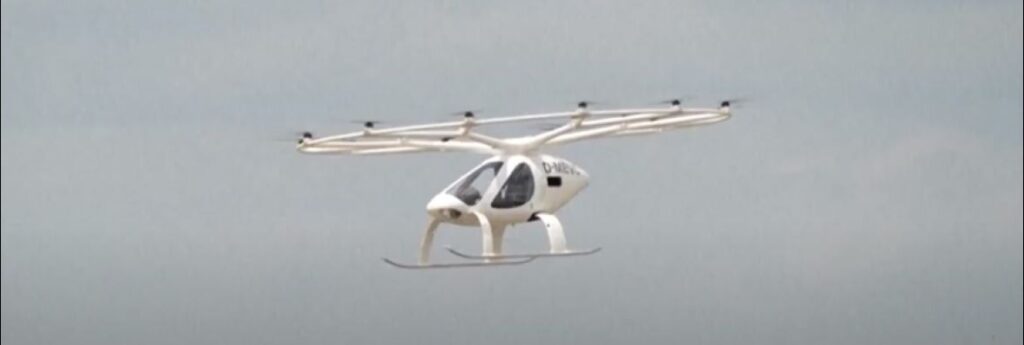After years of dreamy and not always credible talk of skies filled with flying, nonpolluting electric taxis, the aviation industry is preparing to deliver a future that it says is now just around the corner – and a future that is nothing less than a “transport revolution.”
Capitalizing on its moment in the global spotlight, the Paris region is planning for a small fleet of electric flying taxis to operate on multiple routes when it hosts the 2024 Olympic and Paralympic Games next summer. Unless aviation regulators in China beat Paris to the punch by greenlighting a pilotless taxi for two passengers under development there, the French capital’s prospective operator – Volocopter of Germany – could be the first to fly taxis commercially if European regulators give their OK.
Those pioneering first flights would still be just small steps for the nascent industry that has giant leaps to make before flying taxis are muscling out competitors on the ground.
The limited power of battery technology restricts the range and number of paying passengers they can carry, so eVTOL hops are likely to be short and not cheap at the outset.
And while the vision of simply beating city traffic by zooming over it is enticing, it also is dependent on advances in airspace management. Manufacturers of eVTOLs aim in the coming decade to unfurl fleets in cities and on more niche routes for luxury passengers, including the French Riviera. But they need technological leaps so flying taxis don’t crash into each other and all the other things already congesting the skies or expected to take to them in very large numbers – including millions of drones.
Starting first on existing helicopter routes, “we’ll continue to scale up using AI, using machine-learning to make sure that our airspace can handle it,” said Billy Nolen of Archer Aviation Inc. It aims to start flying between downtown Manhattan and Newark’s Liberty Airport in 2025. That’s normally a one-hour train or old-fashioned taxi ride that Archer says its sleek, electric four-passenger prototype could cover in under 10 minutes.
Nolen was formerly acting head of the Federal Aviation Administration, the US regulator that during his time at the agency was already working with NASA on technology to safely separate flying taxis. Just as Paris is using its Olympic Games to test flying taxis, Nolen said the 2028 Los Angeles Olympics offer another target for the industry to aim for and show that it can fly passengers in growing numbers safely, cleanly, and affordably.
“We’ll have hundreds, if not thousands, of eVTOLs by the time you get to 2028,” he said.
The “very small” hoped-for experiment with Volocopter for the Paris Games is “great stuff. We take our hats off to them,” he added. “But by the time we get to 2028 and beyond … you will see full-scale deployment across major cities throughout the world.”
Yet even on the cusp of what the industry portrays as a revolutionary new era kicking off in the city that spawned the French Revolution of 1789, some aviation analysts aren’t buying into visions of eVTOLs becoming readily affordable, ubiquitous, and convenient alternatives to ride-hailing in the not-too-distant future.
And even among eVTOL developers who bullishly talk up their industry’s prospects, some predict that rivals will run dry of funding before they bring prototypes to market.
Morgan Stanley analysts estimate the industry could be worth $1 trillion by 2040 and $9 trillion by 2050 with advances in battery and propulsion technology. Almost all of that will come after 2035, analysts say, because of the difficulty of getting new aircraft certified by US and European regulators.
“The idea of mass urban transit remains a charming fantasy of the 1950s,” said Richard Aboulafia of AeroDynamic Advisory, an aerospace consultancy.
“The real problem is still that mere mortals like you and I don’t get routine or exclusive access to $4 million vehicles. You and I can take air taxis right now. It’s called a helicopter.”
Still, electric taxis taking to Paris’ skies as Olympians are going faster, higher, and stronger could have the power to surprise – pleasantly so, Volocopter hopes.
One of the five planned Olympic routes would land in the heart of the city on a floating platform on the spruced-up River Seine. Developers point out that ride-hailing apps and E-scooters also used to strike many customers as outlandish. And as with those technologies, some are betting that early adopters of flying taxis will prompt others to try them, too.
“It will be a total new experience for the people,” said Dirk Hoke, Volocopter’s CEO. “But 20 years later someone looks back at what changed based on that and then they call it a revolution. And I think we are at the edge of the next revolution.”

